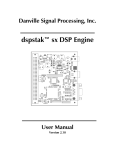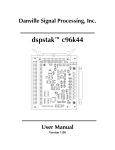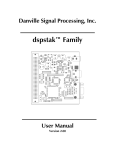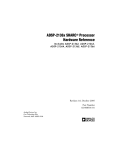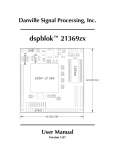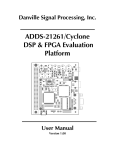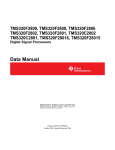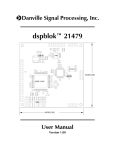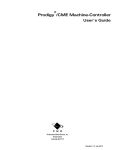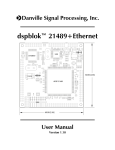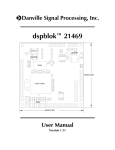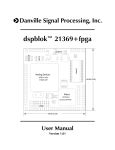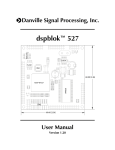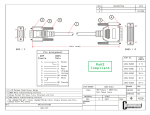Download dspstak™ 21369 User Manual - Danville Signal Processing, Inc.
Transcript
Danville Signal Processing, Inc. dspstak™ 21369 Family User Manual Version 1.00 Danville Signal Processing, Inc. dspstak™ 21369 Family User Manual Copyright © 2006 Danville Signal Processing, Inc. All rights reserved. Printed in the USA. Under the copyright laws, this manual may not be reproduced in any form without prior written permission from Danville Signal Processing, Inc. Danville Signal Processing, Inc. strives to deliver the best product to our customers. As part of this goal, we are constantly trying to improve our products. Danville Signal Processing, Inc., therefore, reserves the right to make changes to product specification or documentation without prior notice. Updated operating manuals and product specification sheets are available at our website for downloading. This manual may contain errors, omissions or “typo’s”. Please send your comments, suggestions and corrections to: Danville Signal Processing, Inc. 38570 100th Avenue Cannon Falls, MN 55009-5534 Trademark Notice dspstak and dspblok are trademarks of Danville Signal Processing, Inc. VisualDSP++, EZ-Kit, VisualAudio and SHARC are trademarks of Analog Devices, Inc. CyberClocks is a trademark of Cypress Semiconductor Corporation. Windows is a trademark of Microsoft Corporation. Contact Information Danville Signal Processing, Inc. 38570 100th Avenue Cannon Falls, MN 55009 E-mail: Web Site: [email protected] http://www.danvillesignal.com Voice: Fax: 507-263-5854 877-230-5629 dspstak™ 21369 User Manual Page 2 Table of Contents Overview ..........................................................................5 Introducing dspstak™.............................................................................5 dspstak™ 21369 ....................................................................................5 Introduction...........................................................................................7 Hardware Description......................................................9 dspblok 21369zx ...................................................................................9 Power Supply ........................................................................................9 RS-232 Interface ..................................................................................10 USB Interface (zx versions only) ...........................................................11 USB Interface (zx2 versions only) .........................................................11 Interconnect Port .................................................................................12 Programmable Clocks ..........................................................................12 JTAG Emulation Port ............................................................................12 EZ-Kit Style Debugger (ICE versions only) .............................................13 dspstak™ 21369 Architecture ........................................14 System Description ..............................................................................14 DAI......................................................................................................15 DPI ......................................................................................................15 External Port ........................................................................................16 I/O Register & DPI Expansion...............................................................16 I/O Register Map..................................................................................17 I/O Register Commands .......................................................................17 Programming the Clock........................................................................19 dspstak I/O Expansion....................................................21 Interconnect Port .................................................................................21 Development Tools ........................................................23 dspstak™ 21369 User Manual Page 3 Visual DSP++ 4.5 for SHARC .............................................................23 VisualAudio .........................................................................................24 EZ-KIT style Debugger (with ICE versions) ............................................24 Installing Visual DSP++ 4.5 (Kit License, with ICE versions) .................24 Installing the debugger in Visual DSP++ 4.5 (ICE versions) ..................25 Power-up Procedure............................................................................25 Programming the dspstak™ 21369 ................................26 Programming Modes............................................................................26 Boot & Clock Configuration .................................................................27 Uploading Programs – Modes 6 & 7.....................................................27 Uploading Procedure...........................................................................28 Software..........................................................................30 Schematic .......................................................................30 Mechanical Drawings.....................................................30 Product Warranty ...........................................................31 RoHS & WEEE Compliance.............................................32 dspstak™ 21369 User Manual Page 4 Overview DSP-based embedded applications often take the form of a digital signal processing engine coupled with a specialized data conversion and signal conditioning front end. The front end electronics and the DSP are almost always connected via high speed serial ports and the general purpose I/O ports of the DSP. In most cases, once the local memory and peripheral interfacing needs of the DSP are fulfilled, the DSP’s data and address busses are no longer needed. Standardized bus architectures such as PC/104, PCI and cPCI are all based on communicating via each board’s data and address bus, while ignoring the needs of the most DSP / data conversion interfaces. Introducing dspstak™ Danville’s dspstak modules are designed to simplify DSP-based embedded applications. Generally, each dspstak consists of two or more modules: a DSP Engine, and a signal conditioning/data conversion I/O Module(s). The Interconnect Port consists of SPORTs (high speed serial ports), SPI, general I/O, clocks and power connections. DSP Engine modules generally consist of a DSP processor, memory, power supplies and standard digital I/O such as RS-232 and USB. We currently have products based on Analog Devices’ SHARC® processors. The I/O Modules may include signal conditioning electronics, A/D and/or D/A data converters, audio transceivers, unique connectors and a plethora of other special front end requirements. Since the I/O Module is separate from the DSP Engine Module, custom interfaces can be created quickly and inexpensively. Danville has a number of standard I/O Modules and often is willing to create a new one based on customer request. You can also create your own. dspstak™ 21369 This manual covers the dspstak 21369 family of DSP Engines and is complemented by the dspstak Family Users Manual. The family manual covers topics that all dspstaks have in common. You will want to review the family manual for mechanical dimensions, system configurations, basic connector specifications, etc. The dspstak 21369 manual covers topics that are relevant to the specific implementation of dspstak 21369 DSP Engines. Currently, there are four members of this family. • • dspstak 21369zx dspstak 21369zx with ICE dspstak™ 21369 User Manual Page 5 • • dspstak 21369zx2 dspstak 21369zx2 with ICE Most of the features of these products are identical. When we are describing these common features, the product will be referred to as dspstak 21369. The products vary in two ways: the choice of USB interfaces and whether a built in EZ-KIT style debugger (ICE) is included. The dspstak 21369zx and dspstak 21369zx with ICE include a USB interface based on an FTDI FT245RL. This USB interface is very easy to use and has support for most popular operating systems. In general, it looks like a very fast COM port to the computer. In many cases, a terminal program is all that is needed to use this interface. The main limitation of this interface is that it is restricted to full speed (12Mb/s) and therefore limited in the amount of data that can be transferred. We suggest using this version when the USB acts primarily as a control port. The dspstak 21369zx2 and dspstak 21369zx2 with ICE include a USB interface based on a PLX NET2272. This device is capable of high-speed transfers (480Mb/s). It is very similar to the USB interface used in Analog Devices’ SHARC USB EZ-Extender. There is USB driver support for Windows XP and 2K included in Visual DSP++ 4.5. These include a high-speed bulk driver and an audio class driver. In general, you would use these drivers as part of a software application written for Windows. The audio driver works like a sound card. The “with ICE” versions are used during the development process. They have exactly the same footprint as the production versions. This allows you to develop your product without an external emulator and then substitute lower cost boards when your product is ready for production. The “with ICE” boards are supported by Visual DSP++. You can use a free KIT license (same restrictions as an EZ-KIT) or the full-featured version. Danville also has platform files for Analog Devices’ VisualAudio graphical development tool. Most of our dspstak 21369 – dspstak I/O module combinations are supported. All dspstak 21369 boards have JTAG connections to accommodate an ADI HPUSB or USB ICE. If you have one of these emulators, then any version of the dspstak 21369 can be used for development. Intended Audience The dspstak 21369 is intended for DSP systems integrators, designers and programmers who may wish to integrate a dspstak into their products. This manual is primarily aimed at users who have a working knowledge of microcomputer technology and DSP related design. We assume that you are familiar with the Analog Devices ADSP-21369 SHARC DSP. dspstak™ 21369 User Manual Page 6 Introduction The dspstak™ 21369 is a high performance digital signal processing engine based on the Analog Devices ADSP-21369 SHARC DSP. The ADSP-21369 supports 32 bit fixed point and 32/40 bit floating point formats with SIMD instructions running at up to 333 MHz. This translates to a peak computation rate of 2.0 GFLOPS. The ADSP-21369 has very flexible peripherals including up to 8 independent serial ports (SPORTs), 8 sample rate converters (SRCs), 2 SPI ports, TWI (I2C), and 2 UARTs. The heart of the dspstak 21369 is Danville’s dspblok 21369zx DSP Module. This module includes flash, SDRAM and EEProm memory. The dspblok 21369zx is also available as a standalone module for integration into other boards. You may wish to review the dspblok 21369zx User Manual for more information. The dspstak 21369 Interconnect Port supports the complete DAI interface, SPI, general I/O, clocks and power connections. The dspstak 21369 also includes USB and RS-232 ports for easy interfacing to the outside world. Program development is very easy with the dspstak 21369. The “with ICE” versions includes a builtin emulator similar to the debugger that is built into Analog Devices’ EZ-Kit family of evaluation boards. This technology was provided by Analog Devices and is licensed to Danville Signal Processing. The emulator is supported by Visual DSP++ (Version 4.5 and later). Since it looks like an EZ-Kit to Visual DSP++, you may use the debugger with an EZ-Kit license (free, with performance restrictions) or you may use it with a Full Visual DSP++ license. A JTAG interface is also available to connect an Analog Devices external ICE. The dspstak 21369 includes the following items: Hardware: • dspstak 21369 board (including dspblok 21369zx) Documents & Programs (CD): • • • • • This Manual dspstak Family User Manual dspblok 21369zx User Manual Free Terminal Program – Tera Term Pro USB Device Driver dspstak™ 21369 User Manual Page 7 Firmware (CD): • • Sample Programs VisualAudio platform files Development Tools (ICE Versions Only): • • • Analog Devices’ Visual DSP ++ 4.5 – KIT Version Visual DSP++ Installation file Cables Schematics (CD): • • dspblok 21369zx dspstak 21369 We recommend that you have the following tools and documents: • • • • • • Analog Devices VisualDSP++™ for SHARC® (Version 4.5 or later) Analog Devices ADSP-21368 SHARC Hardware Reference Manual Analog Devices ADSP-2136x SHARC Processor Programming Reference Manual Analog Devices ADSP-21160 SHARC Instruction Set Reference Manual Analog Devices ADSP-21369 Product Data Sheet Cypress Semiconductor CyberClocks™ You may also want the following tools and documents for more advanced development: • • Analog Devices HP ICE Danville JTAG Adapter (required for ADI ICE) Danville is an authorized reseller of ADI tools including Visual DSP++ and the emulators. If you need one of these tools, we would appreciate your business. Our website (www.danvillesignal.com) has downloads and links to other supplementary tools and documents. dspstak™ 21369 User Manual Page 8 Hardware Description The dspstak 21369 includes all dspstak DSP Engine standard features. These features are discussed in a general way in the dspstak Family Users Manual and are as follows: • • • • • • Power Supply RS-232 Interface USB Interface Interconnect Port Programmable Clock JTAG Ports Each of these areas is discussed in more detail in this manual. Even though this manual addresses the dspstak 21369 specifically, there are several related products that may be important to you. The third generation SHARC family includes several pin compatible parts. These DSPs may have special licensed algorithms programmed into their ROM (ADSP-21367 for example) or enhanced peripherals (ADSP-21368 for example). Danville offers dspstak products that support these processors. Since the core of the dspstak 21369 platform is a dspblok module, exchanging dspblok modules is an easy way to support different DSPs and core functions. You can also use the dspblok as a component in your own target. In this case, the dspstak baseboard is a useful test platform. dspblok 21369zx The heart of the dspstak 21369 is a dspblok 21369zx. This module includes the ADSP-21369 DSP, flash memory, EEProm and SDRAM. You can use a dspblok 21369zx as an independent building block module and you can use it as the DSP Engine component in a dspblok system. Details of the dspblok 21369zx are covered in the dspblok 21369zx User Manual. Power Supply The dspstak 21369 uses a standard 2.1/5.5mm coaxial power jack to provide power to itself and also any I/O modules via the Interconnect Port. From the dspstak 21369 view, this supply may be either an AC supply or a DC supply with the center of the coaxial power plug connected as the positive pin. Adjacent to the coaxial jack, there are 3 pads spaced at 0.100 inch that may be used as an alternative connection to provide a bipolar DC supply to the board. These pads are labeled JH7 and can accommodate a .025 header or similar connector. dspstak™ 21369 User Manual Page 9 The incoming voltage is half wave rectified to create new unregulated DC supplies called Va+ and Va-. From these unregulated supplies, Va+5 (5.0 Volt Analog) and Vd+5 (5.0 Volt Digital) are created and made available to the I/O Modules via the Interconnect Port. Vd+5 is the same as Va+5 with a different ground return. It is included for compatibility with older dspstak DSP Engines. An additional internal supply is also created to provide the input to switching regulators that are used for digital supplies. The main dspstak digital supply is Vd+3.3 (3.3V). The dspblok 21369 includes a switching supply for its core power supply requirement. The dspstak 21369 DSP Engine does not use Va+, Va-, Va+5 or Vd+5. These supplies are available to I/O Modules. If the I/O Module does not need a negative supply, you can power the dspstak 21369 with only a positive DC power supply. The recommended input voltages are 9 VAC or 9 to 15VDC. Since switching regulators are used for the digital supplies, the input voltage is not critical. In all cases, the DC supply or an unregulated DC supply created from an incoming AC supply should be less than 20VDC. This will protect both the DSP Engine and probably the components on the I/O Module. One final thing to remember: The nominal output voltage of a wall adapter is usually much lower than its actual output voltage. We recommend that unregulated DC wall adapters should have a maximum nominal voltage of 12VDC. RS-232 Interface The RS-232 interface is used to upload user application programs for the DSP. An application program may also use the RS-232 interface for its own purposes. The RS-232 interface is configured as a DCE (Data Communications Equipment) device. It uses a DB-9F connector that is designed to mate without crossover connections to the DB-9M connector found on PC compatible computers. Connections are defined in the following table: Signal DCD RD TD DTR SIGNAL GND DSR RTS CTS RI Direction DCE -> DTE DTE -> DCE DTE -> DCE DCE -> DTE dspstak™ 21369 User Manual Pin 1 2 3 4 5 6 7 8 9 Notes DCD, DTR & DSR are connected together DCD, DTR & DSR are connected together DCD, DTR & DSR are connected together dspstak I/O Register 0 dspstak I/O Register 0 NC Page 10 When the dspstak 21369 is programmed using the RS-232 interface, only RD & TD are used. DTR, DSR & DCD are simply connected together and ignored by the dspstak. Since the RS-232 port is used in a very standardized manner, a USB to RS-232 converter can be used with computers that no longer support RS-232 serial communications. USB Interface (zx versions only) The zx USB interface is another way that programs may be uploaded to the dspstak. This interface should not be confused with the debugger (on board ICE), which uses its own mini-B USB connector. The USB interface is also available for user applications. A device driver is included with the dspstak 21369 to support Windows 2000 & Windows XP applications. The USB connection is made via a standard USB type B connector. The USB port on the dspstak 21369zx uses an FTDI FT245RL USB transceiver. This device is a USB 2.0 compliant, full speed part (12Mb/s). This part is very easy to use since in most cases it just looks like a COM Port to the USB Master. FTDI has royalty free device drivers on their web site that support a variety of operating systems. We suggest that you visit their web site (www.ftdichip.com) for additional information. We supply Windows® drivers on our distribution CD. The driver files includes dspstak *.inf files that are used for installation in Microsoft Windows® operating systems. If you are using another OS, you may want to compare the ftdibus.inf and ftdiport.inf files to the dspstakbus.inf and dspstakport.inf files to configure your driver. Instructions on installing the Windows® drivers are on the CD. The zx USB registers are mapped into the dspstak I/O register space. There is an example of how to read and write the USB included in the sample software on the CD. USB Interface (zx2 versions only) The zx2 USB uses a PLX NET2272 USB transceiver. This device is a USB 2.0 compliant, high-speed part (480Mb/s). It is supported with two Windows device drivers supplied with Visual DSP++ 4.5 as part of the 213xx examples (../Visual DSP 4.5/213xx/Examples/USB EZ-Extender). The circuit implementation is functionally identical with the exception of the line used for reset. The distribution CD includes a dspstak 21369 implementation of the ADI examples. Presently, The zx2 USB port cannot upload code to the dspstak 21369 flash. This function is handled exclusively by the RS-232 port. dspstak™ 21369 User Manual Page 11 The USB connection is made via a standard USB type B connector. This interface should not be confused with the debugger (on board ICE), which uses its own mini-B USB connector. Interconnect Port The Interconnect Port is the only standard connection between the DSP Engine and I/O Modules. This port is described in detail in the dspstak Family Users Manual and the dspstak I/O Expansion section of this manual. Programmable Clocks The dspstak 21369 has a very flexible clock configuration. A user reprogrammable clock generator provides the DSP clock and three I/O clocks that are available on the Interconnect Port. The three programmable clocks on the Interconnect Port allow I/O Modules to use convenient clocks for whatever devices that might be present. For example, an ADC might use an 18.432 MHz MCLK to sample at 96k or a 19.6608 MHz MCLK to sample at 102.4k. In addition to the on-board programmable clock, the DSP clock can also be provided externally by a dspstak I/O Module. The dspstak 21369 uses a Cypress Semiconductor CY22393 flash programmable clock generator. This device has three PLLs which when combined with the reference oscillator can create four independent clock frequencies. Cypress has a program called CyberClocks on their web site (www.cypress.com) that you can use to create a JEDEC file to reprogram the clock chip. There are two standard clock configurations that are available by selecting the Clock Select Bit in the dspstak I/O register. The CY22393 is also reconfigurable by directly writing its registers via TWI (I2C). There are supporting library functions in the code examples. In many cases, the factory default settings are appropriate and no changes are ever necessary. JTAG Emulation Port The dspstak 21369 has a right angle 2mm connector mounted on the dspblok assembly. This connector is accessible even when a dspstak I/O Module is positioned above the dspstak 21369. The JTAG connector is smaller than the standard ADI JTAG header. The Danville JTAG connector is a male 16 pin, 2mm dual row header. A JTAG adapter is available from Danville to convert the 2mm header to the 0.100 headers used by the Analog Devices emulators. If you are using an external ICE for the DSP, the built-in debugger is automatically disconnected. When you are not using an ICE or ByteBlaster, leave the JTAG pins open. dspstak™ 21369 User Manual Page 12 EZ-Kit Style Debugger (ICE versions only) The dspstak 21369 debugger uses a mini-b USB connector (J5). The technology is provided under license from Analog Devices for use with the dspstak 21369. It is not Danville’s property and therefore we will not discuss specifics or disclose circuit information. Here are the important facts: • • • • • It is supported by Visual DSP++ (Version 4.5 or later). It looks like an EZ-Kit to Visual DSP++. You can use the EZ-Kit license with the feature restrictions or you can use a full Visual DSP++ license. We include an installation CD of Visual DSP++ 4.5 with a KIT license. You should install any updates that are on the Analog Devices website and register the product with ADI. It only supports the ADSP-21369 on the dspstak. Contact Danville if you want to use a different DSP processor. dspstak™ 21369 User Manual Page 13 dspstak™ 21369 Architecture System Description The dspstak 21369 platform is intended for embedded signal processing applications where the benefits of a 32 bit fixed and floating point DSP are apparent. The dspstak architecture is tailored to take advantage of the third generation SHARC DSP family. These issues are discussed in more detail in our dspstak Family User Manual (Version 2.00). The block diagram above illustrates the basic dspstak 21369 architecture with all the variations on the same drawing. The ADSP-21369 has a rich set of peripherals, which are extended by the addition of a USB transceiver and a programmable clock generator. The core functions are provided by a dspblok 21369zx, which includes the DSP, flash, EEProm and SDRAM. I/O is connected to the dspstak 21369 via the Interconnect Port. This is a 96 pin DIN connector that is described in detail in its own section in this manual. dspstak™ 21369 User Manual Page 14 A major requirement for a general-purpose solution such as the dspstak 21369 is that resources cannot be squandered. It is very important that the dspstak core maintain maximum flexibility since the exact user application is not known ahead of time. The logical starting place to consider is the DSP since all the other components are “supporting cast”. The DSP has the following external interfaces: • • • Digital Audio Interface (DAI) Digital Peripheral Interface (DPI) External Port DAI The DAI is comprised of a group of peripherals including the SPORTs and a signal routing unit. There are 20 pins on the DSP that connect the DAI to the outside world. All 20 DAI pins are available on the Interconnect Port. It is the DAI that really enables a dspstak to work with a large number of different I/O requirements. Most digital signal (and general purpose) processors have a finite number of peripherals that are individually mapped to specific pins on the device. If you want to support a large number of options, you need a large number of pins. Since larger pin counts usually means higher cost, there is a tendency to have fewer features. Of course, most applications don’t need all the possible features, but the set they do need is seldom universal. The third generation SHARC solves this problem by providing a large number of peripherals behind a 20 pin crossbar switch (the DAI). In the ADSP-21369, there are 8 SPORTS, 8 sample rate converters (SRCs), an S/PDIF transceiver, 4 precision clock generators (PCGs) and a high-speed parallel input FIFO. The DAI pins can also function as general purpose I/O. The DAI allows you to select the ones you want in an “a la Carte” fashion. The dspstak 21369 does not use any of the DAI pins for internal functions, therefore all DAI pins are available for dspstak I/O. DPI The DPI expands on the DAI concept by abstracting the general-purpose microcontroller peripherals to 14 assignable pins on the DSP. Earlier third generation SHARCs like the ADSP-21262 have fewer peripherals so dedicated pins were used or in some cases shared with the DAI. dspstak™ 21369 User Manual Page 15 The DPI provides 2 SPI ports, 2 UARTs, a TWI (I2C) port, and general purpose I/O. The dspstak 21369 takes advantage of many of these built-in peripherals so unlike the DAI, many of the DPI pins are not externally available. Most modern data converters and many other devices rely on SPI communications for control and configuration. The dspstak places a strong emphasis on SPI based communications, therefore additional hardware support has been added to expand SPI capabilities via the Interconnect Port. There are two SPI ports on the ADSP-21369. The dspstak 21369 uses SPI 0 as its primary SPI interface. The DSP is always the master and uses this interface to boot from flash, read/write external memory, configure I/O, etc. The remaining SPI port is unused and could be configured as a slave for an external processor interface. The TWI (I2C) interface is used internally to control the programmable clocks. It could be reassigned to external pins on the Interconnect Port. UART 0 is used for the RS-232 interface. In addition to the SPI 0 port, there are five DPI pins that are available on the Interconnect Port. External Port The external port provides an asynchronous data bus and supports 32 bit wide 133 MHz SDRAM. 64Mbit (2M x 32) SDRAM is provided as part of the dspblok 21369zx. The data bus is used to expand the local I/O of the dspstak 21369 including connections to the USB transceiver. The external port is not expanded to off board connectors to insure that all high-speed bus communications are successful. Applications that require access to the asynchronous data bus, may want to consider using a dspblok 21369zx independently. I/O Register & DPI Expansion A PLD is used to expand I/O via the External Port using #MS2, A1 & A0. This mapping defines four register addresses. Only the lowest byte (D7-D0) is valid, the upper bytes will read as high and should be masked in software. The PLD is also used to buffer the SPI port where the DSP is always configured as an SPI master. Since dspstak I/O often uses many SPI devices, buffering extends the SPI drive capability and also automatically controls MISO to prevent contention from external devices. With the SPI SS register, multiple devices can be written at the same time with only one device responding if the mask is set correctly. A subset of the I/O Register is implemented in Danville’s dspblok ps-usb and dspblok ps-uart products. The Mode bits are duplicated in Registers 0 & 3 to minimize logic requirements for dspstak™ 21369 User Manual Page 16 dspblok applications. USB RESET in Register 0 is defined as RS-485/RS-422 SELECT in the dspblok ps-uart since it has no need to support the high-speed zx2 USB. The following table shows the I/O Register. Depending on the version of the dspstak 21369, some registers will not be valid since the USB port is implemented differently. You can write any value to the upper bytes of Registers 0, 1 & 2 (Register 3 is read only). These bits do not point any corresponding hardware, however we recommend that you write 0 to these bits for future capability. The upper bytes will return 1’s regardless of any previous writes since the data bus has pull-ups. I/O Register Map Name Addr D7 D6 D5 D4 D3 D2 D1 D0 System 0W GP1 DIR GP1 DIR GP0 DIR GP0 DIR GP1 GP0 CTS GP0 RTS USB RESET MODE 1 RESET GP1 CLK SEL MODE 2 SS4 IO3 SS5 IO4 SS3 IO2 SS4 IO3 SS2 IO1 SS3 IO2 SS1 IO0 SS2 IO1 SS1 IO0 0R SPI SS Notes: MODE 0 1W 1W IR 1R 0 0 0 0 SS5 IO4 0 0 SS FTDI USB 2W 2R D7 D7 D6 D6 D5 D5 D4 D4 D3 D3 D2 D2 D1 D1 D0 D0 MODE USB STATUS 3R 1 MODE 2 MODE 1 MODE 0 0 USB PD USB TXE USB RXF 1 = SPI 0 = I/O Read Only I/O Register Commands This register supports a variety of internal and external functions. GP1 & GP0 are general purpose I/O mapped to the Interconnect Port. CTS & RTS are handshaking lines used for RS232. Note that CTS is an output since the RS-232 port is defined as a DCE. System – Register 0 GP1 DIR: GP0 DIR: GP1: GP0: D7 D6 D5 D4 R/W R/W R/W R/W GP0 Direction 1=Output, 0=Input GP1 Direction 1=Output, 0=Input General Purpose I/O General Purpose I/O CTS: D3 W RS-232 Output – DCE Perspective dspstak™ 21369 User Manual Page 17 RTS: D3 R RS-232 Input – DCE Perspective CLK SEL: D2 USB RESET: D1 RESET: D0 W W W Selects Programmable Clock Settings (CY22393 S2) Resets High Speed USB (ignored in zx) I/O Reset (interconnect Port) MODE : R Mode 7 – Upload code at 115k Mode 6 – Upload code at 19.2k Mode 5, 4 – Reserved Modes 3-0 – User Modes D2-D0 All other bits are Don’t Care. SPI SS – Register 1 SP1 Slave Select is used to enable the MISO buffer when using the pin as a SPI slave select. If the bit is 0, then the pin can be used as general purpose I/O or any other DPI function. If an SPI device is write only (no MISO required), then this setting can be ignored. SS5: IO4: D5 D5 R/W R/W 1 = Slave Select (Flag 0 must be an output) 0 = General Purpose (Flag 0) SS4: IO3: D5 D5 R/W R/W 1 = Slave Select (DPI 14 must be an output) 0 = General Purpose (DPI 14 function) SS3: IO2: D5 D5 R/W R/W 1 = Slave Select (DPI 13 must be an output) 0 = General Purpose (DPI 13 function) SS2: IO1: D5 D5 R/W R/W 1 = Slave Select (DPI 4 must be an output) 0 = General Purpose (DPI 4 function) SS1: IO0: D5 D5 R/W R/W 1 = Slave Select (DPI 8 must be an output) 0 = General Purpose (DPI 8 function) SS: D5 D5 R/W R/W 1 = Slave Select (DPI 7 must be an output) 0 = General Purpose (DPI 7 function) All other bits are Don’t Care. dspstak™ 21369 User Manual Page 18 USB Data (zx version) – Register 2 This is the data bus of the zx USB transceiver. You should not read or write to this register without checking the status bits in Register 3. The zx2 versions do not use this register and will return 0xFF. Mode & USB Status – Register 3 The Mode is identical to the state of Mode in Register 0, The USB status bits are only valid in the zx versions. They will read 1 in zx2 versions. 1: MODE : D7 D6-D4 R R 0: USB PD: USB TXE: USB_RXF: D3 D2 D1 D0 R R R R Always a 1 Mode 7 – Upload code at 115k Mode 6 – Upload code at 19.2k Mode 5, 4 – Reserved Modes 3-0 – User Modes Always a 0 0 = zx USB enumerated 0 = zx USB transmit FIFO not full, can write a byte 0 = zx USB receive FIFO not empty, can read a byte All other bits are Don’t Care. Programming the Clock The dspstak 21369 uses a Cypress Semiconductor CY22393 programmable clock generator to provide clocks for the ADSP-21369 and the Interconnect Port. The Interconnect Port clocks are SYSCLK, MCLK0 & MCLK1. The CY22393 has three independent PLLs that allow you to generate clocks that are appropriate for your situation. The CY22393 starts with a 24.576 MHz crystal based clock to derive the new clocks. The three programmable clocks on the Interconnect Port allow I/O Modules to use convenient clocks for whatever devices that might be present. For example, an ADC might use a 18.432 MHz MCLK to sample at 96k or a 19.6608 MHz MCLK to sample at 102.4k. If you want to reprogram the CY22393, you should review the CY22393 data sheet. You will also need the Cypress program, CyberClocks™ to generate a JEDEC file of clock parameters. The data sheet and the program are available on the Cypress web site and there are links on the Danville web site at http://www.danvillesignal.com. There are two predefined sets of clock frequencies that are be switched by CLK SEL in I/O Register 0. The default settings are Clk Set 0. dspstak™ 21369 User Manual Page 19 Clock Configuration – CY22393 Clock CY22393 Clk Set 1 Clk Set 0 (Default) DSP Clock (JH1 Pins 2&3) SYSCLK MCLK0 MCLK1 Not Used CLKC CLKD CLKA CLKB CLKE 22.1184 MHz 22.1184 MHz 22.5792 MHz 8.192 MHz Off 22.1184 MHz 22.1184 MHz 24.576 MHz 12.288 MHz Off The clock choices are somewhat arbitrary. The DSP clock uses 22.1184 MHz since this ideal for setting the UART to common bauds such as 115.2k and 38.4k. It also conveniently scales to 331.78 MHz by multiplying by 15. This is the maximum core clock supported by the ADSP-21369. MCLK0 & MCLK1 and typically used for audio data converters. The 24.576 MHz and submultiple clocks are reasonably jitter free since they are derived from a 24.576 MHz input clock. You can also change the clock frequencies via software by using the TWI (I2C) interface. The software configuration is volatile whereas the two Clk Sets are preprogrammed into the CY22393. There are software examples to illustrate this method on the CD. You should not change the DSP Clock (CLKC) since this may disrupt the operation of the DSP. You cannot mess up too badly if you make a programming error, since the dspstak 21369 will always start up in Clock Set 0. It is also possible to provide an external clock to the ADSP-21369 via the Interconnect Port. In this configuration, JH1 Pins 1&2 are shorted. It might be prudent to disable the DSP Clock (CLKC) in this situation. dspstak™ 21369 User Manual Page 20 dspstak I/O Expansion The Interconnect Port is the interface between dspstak DSP Engines and I/O Modules. It consists of SPORTs (high speed serial ports), SPI, general I/O, clocks and power connections. There are several general rules to consider: • • • • The Interconnect Port is largely unbuffered. It is not designed to drive long lines, especially at high speeds. It is designed to interface to the boards comprising a dspstak. The digital I/O is always based on 3.3V level logic. It is not 5V tolerant! dspstaks are not hot swappable! You can of course, create hot swappable interfaces on a dspstak I/O Module, but don’t plug a dspstak I/O module into a live dspstak DSP Engine. If you need to interface to a much larger system or accommodate different voltage levels, use a dspstak I/O Module to create a more robust interface. Additional details are covered in the dspstak Family Manual and the individual dspstak I/O manuals. Interconnect Port Row A&C B Name Notes 1 2 3 4 5 * * * * * * * * * * AGND Va+ VaVa+5 AGND Analog Ground Unregulated Positive Analog Supply Unregulated Negative Analog Supply Regulated Analog +5.0 Volt Supply Analog Ground 6 7 8 * * * * * * Vd+5 Vd+3.3 DGND Digital 5.0 Volt Supply Digital 3.3 Volt Supply Digital Ground – Main Return 9 9 10 10 11 11 12 12 13 13 * IO0/#SS1 (DPI 8) IO1/#SS2 (DPI 4) IO2/#SS3 (DPI 13) IO3/#SS4 (DPI 14) IO4/#SS5 (FLG 0) DAI 2 DAI 3 DAI 1 #SS0 (DPI 7) SPICLK 3.3V Digital I/O or SPI SS 3.3V Digital I/O or SPI SS 3.3V Digital I/O or SPI SS 3.3V Digital I/O or SPI SS 3.3V Digital I/O or SPI SS * * * * * * * * * dspstak™ 21369 User Manual Primary SPI Slave Select SPI Clock – Buffered Page 21 Row A&C 14 14 15 15 16 16 17 17 18 18 19 19 20 20 21 21 22 22 23 23 24 24 25 25 26 26 27 27 28 28 29 29 30 30 31 31 32 32 * B * * * * * * * * * * * * * * * * * * * * * * * * * * * * * * * * * * * * * Name Notes SPISO SPISI DAI 4 #RESET SYSCLKIN SYSCLKOUT Vd+3.3 GND DAI 5 DAI 6 GND MCLK0 DAI 7 DAI 8 DAI 9 DAI 10 GP0 GND DAI 11 DAI 12 GND Vd+3.3 Vd+3.3 GND DAI 13 DAI 14 GND MCLK1 DAI 15 DAI 16 DAI 17 DAI 18 GP1 GND DAI 19 DAI 20 GND Vd+3.3 SPI Serial Out (MISO) - Buffered SPI Serial In (MOSI) - Buffered dspstak™ 21369 User Manual System Reset – Open Drain External DSP Clock Input Programmable clock Programmable Clock 3.3V Digital I/O Programmable Clock 3.3V Digital I/O Page 22 Development Tools The dspstak 21369 is supported by Visual DSP++ 4.5 or greater. If you have an earlier version of Visual DSP, we suggest that you upgrade to the latest version. Analog Devices also has regular service packs on their website so you want to check to see that you have the latest build. Danville is also supporting the dspstak 21369 with a variety of VisualAudio platform files. Analog Devices’ VisualAudio is a graphical development environment that streamlines code development by combining optimized building block functions with an easy-to-use graphical interface. You use it as a front end to Visual DSP++. We have additional information on our website: www.danvillesignal.com. We strongly suggest that you use either an ICE such as Analog Devices’ HPUSB-ICE or use one of the dspstak 21369 with ICE versions. All dspstak 21369 boards support the ADI ICE with the use of a Danville JTAG adapter (P/N A.08151A). Visual DSP++ 4.5 for SHARC Visual DSP++ comes in three basic licensed versions. These are as follows: • • • Full Version Test Drive Kit Version The Full version provides all the features of Visual DSP++. It supports the Analog Devices standalone ICE (HPUSB-ICE, for example) as well as the built in EZ-KIT style debuggers (our “with ICE” is a licensed EZ-KIT style debugger). If you have an earlier Visual DSP++ for SHARC version, you can update to 4.5 for free. Check the ADI web site for details. The Test Drive Version functions the same as a Full version with a 90 Day time limit. The Kit license is free. It supports Analog Devices’ EZ-KITs and also our dspstak 21369 with ICE Versions. The Kit license starts out just like a Test Drive (or Full) version. After 90 days, the Kit version will no longer support the standalone ICE or the simulator. It also restricts the maximum program size to 10922 words of memory with no restrictions on data space. You must also be attached to the EZ-KIT style (our ICE) debugger. You can still create bootable images of your finished application code to load to production versions. If you have a dspstak 21369 with ICE version, we supply a copy of Visual DSP++ 4.5 for SHARC with a KIT license. You can also purchase a Full Visual DSP++ license from Danville. We are dspstak™ 21369 User Manual Page 23 authorized resellers of Analog Devices Development Tools including all versions of Visual DSP++ and the ICE. VisualAudio VisualAudio is a front end for VisualDSP++. You can development production quality code very quickly with this tool. Here is the basic design method: • • • • • • Create a graphical layout of your application in Visual Audio Compile and load into Visual DSP ++ Modify code in C or ASM in VisualDSP++ as needed Build the Project and download via the ICE Run the application on the dspstak 21369 system Tune the parameters in real time from VisualAudio Don’t let the name VisualAudio keep you from exploring this tool. It’s useful for non-audio applications as well. There’s really no risk in using this product, it’s free! We are committed to supporting this product and have more info on our web site. EZ-KIT style Debugger (with ICE versions) Danville Signal licenses the EZ-KIT style debugger from Analog Devices. From a Visual DSP++ point of view, the dspstak emulates an EZ-KIT. The debugger uses a mini-B USB connector that is located on the edge of the PCB. Do not confuse this USB connector for the larger USB – B connector that is located next to the DB-9 connector. Installing Visual DSP++ 4.5 (Kit License, with ICE versions) If you do not currently have Visual DSP++ for SHARC installed, you can install the KIT version from the CD that is included with the dspstak 21369 with ICE versions. Follow ADI’s installation instructions and make sure you use the default directory structure. This is important for the dspstak with ICE debugger installation described in the next section. You will need to register the license with ADI. You will need the hard drive ID from your computer and the KIT license number which is on the jacket or jewel case of the CD. You can get the hard drive ID from Start >> Run >> Command >> dir /p. The hard drive (volume serial) number is 8 digits and looks something like this: ????-???? Registration page: http://forms/analog.com/Form_Pages/DSP/products/visualDSPRegistration.asp Select Danville dspstak from the product list. dspstak™ 21369 User Manual Page 24 Installing the debugger in Visual DSP++ 4.5 (ICE versions) You need to install a device driver for the debugger. This is true for all Visual DSP++ 4.5 licensed versions. The procedure is simple and as follows: 1. Copy the inf file: dspstak_21369_EZ_KIT_ICE.inf into the ..VisualDSP 4.5\Setup\Emu_Drivers directory. This file is on the dspstak CD. 2. Update the registry by simply clicking on the dspstak_21369_ICE_registry.reg file that is also on the dspstak CD. It is important that the default directory structure for Visual DSP is used. Consult Danville if you have a different directory structure. Here is the expected directory structure: C:\Program Files\Analog Devices\VisualDSP 4.5\…….. If your installation is successful, you will see Danville Signal Processing dspstak 21369 in the platform templates. Here is the procedure: 1. 2. 3. 4. 5. Start Visual DSP++ Session >> New Session New Session >> Select Processor >> Processor Family >> SHARC Target Processor >> ADSP-21369 Configurator >> Platform Templates >> Danville Signal Processing dspstak 21369 Power-up Procedure 1. 2. 3. 4. Connect your dspstak system together. Power the dspstak. Connect power to Analog Devices ICE (if used). Plug in the USB cable to either the ICE or the on-board EZ Kit debugger. This is a mini B connection. 5. Start Visual DSP++ 6. Create a new session if needed. 7. Connect to Target if needed. dspstak™ 21369 User Manual Page 25 Programming the dspstak™ 21369 The dspstak 21369 can be programmed in a variety of ways. In most cases, programs are uploaded via either the USB port (zx versions) or the RS-232 port into the on-board serial flash memory. You may also load and execute programs through the JTAG port by using either the built in debugger (with ICE versions) or an external emulator. Programming Modes The dspstak 21369 has eight different programming modes that are assigned via jumper on the Configuration Header (JH9). The purpose of the programming modes is to establish what the dspstak 21369 will do when it comes out of reset. Four of the programming modes are reserved for standard dspstak 21369 functions and the remaining four are available for user programs. For example, you could use Mode 0 as a means to bootload one version of your application and use Mode 1 to bootload another. The dspstak 21369 uses Mode 7 and Mode 6 as Program Uploading Modes. Mode is read by the Danville bootloader and can be read in either I/O Register 0 or Register 3. JH9 is a 2x8 header located on the edge of the pcb assembly. The Mode pins use pins 1 thru 6; the remaining pins are used for factory programming and diagnostics and should always be left open. Each Mode bit is labeled on the silkscreen of the pcb as M2, M1 or M0. A shorting jumper causes the Mode bit to be 0, therefore if no jumpers are installed, the dspstak is configured in Mode 7. Mode – Jumpers (JH5) Mode 0 1 2 3 4 5 6 7 Name M2 M1 M0 User 0 User 1 User 2 User 3 Reserved Reserved Program Uploading – RS-232 at 19k Baud Program Uploading – RS-232 at 115.2k Baud On On On On Off Off Off Off On On Off Off On On Off Off On Off On Off On Off On Off * Jumper On = 0 dspstak™ 21369 User Manual Page 26 Boot & Clock Configuration The DSP is configured to boot from serial flash (Boot Mode 01). This mode causes the SPI port to automatically load a DSP program from the flash memory after reset is deasserted. The DSP is configured in hardware for a Core Clock /Clock In ratio of 6:1 (ClkCFg Mode 00). In most cases, the DSP clock is 22.1184 MHz. This causes the DSP to operate at an initial core clock of 132.71 MHz. The DSP can change the ratio via software commands. In the sample DSP programs, we generally reset this ratio to 15:1 so that the DSP operates at 331.78 MHz, which is essentially the ADSP-21369 maximum core clock of 333 MHz. The dspblok 21369zx has a Boot & Clock Mode Configuration Header JH8 (usually not installed). On the dspstak 21369, the boot and clock mode pins should be always left open. Uploading Programs – Modes 6 & 7 The dspstak 21369 uses a 4Mbit SPI serial flash memory device to bootload the ADSP-21369. Since boot mode selection is set for SPI Master Boot, the ADSP-21369 will boot from the SPI flash memory after reset is deasserted. This boot capability is very useful in the ADSP-21369 except that there is no native support in the DSP to program the flash memory. The dspstak 21369 (actually all dspstak DSP Engines) has a resident boot loader and flash writer program that addresses this problem. The dspstak 21369 automatically boots a proprietary Danville program called boot369 that is located in the lowest block of the flash memory. The boot369 program in turn, boots your program file that resides in other sectors of the flash memory. You don’t have to worry about reserving memory for boot369. In the process of loading your program, the boot369 program that resides in internal RAM is overwritten. If the dspstak 21369 is connected to an ASCII terminal via either RS-232 or USB (zx versions) and it is operating in Mode 6 or 7, you have a five second window to interrupt the boot process (hit a key on your terminal) before the application program is automatically loaded. When you interrupt the boot process, the dspstak enters Command Mode. Command Mode lets you upload program files to the flash memory. If the dspstak 21369 is operating in Modes 0 through Mode 3, your program will boot immediately as if the boot369 program didn’t exist. It is still there and it loads your program, but it does so silently. You write your DSP applications as normal and create a *.ldr file (Boot Type = SPI Slave, Format = Binary, Width = 8). dspstak™ 21369 User Manual Page 27 You don’t really need to worry about how your files are stored in the flash memory, but we are going to tell you anyway. Your files start at the beginning of the third block of the flash. The lower blocks hold the bootloader code. There is also an 80H space that is used to store the name of your program, checksums, etc. It resides in front of your code. When you upload a new file, all the memory in the flash is block erased with the exception of the blocks where the boot369 program resides and the last block of the flash. You can to write the last block of the flash memory, but be very careful that the boot369 program is never overwritten or erased. The only way to rewrite boot369 is with an emulator. It is very hard to damage the contents of the flash by accident, but it is possible. If you never write directly to the flash, you are unlikely to ever see a problem. Danville supplies sample code that manages the SPI bus where the flash memory resides. This code makes it even more difficult to write to the flash inadvertently. Uploading Procedure Command mode is available via either the zx USB port or the RS-232 port. A USB device driver is included that emulates a COM port for Windows 2000 or Windows XP operating systems. Bootloader communications automatically switch between the RS-232 port and the USB port. If the USB port is active (enumerated), the USB port is used; otherwise, the RS232 port will be active. Here are the basic steps to uploading programs: • Configure the dspstak 21369 to operate in Mode 6 or Mode 7. • Connect to an ASCII Terminal Program via RS-232 or USB. USB is faster. o If RS-232 is used, a 9 pin to 9 pin cable with no twists is appropriate on PC compatible computers. The serial configuration is 115.2K, N, 8, 1 for Mode 7 and 19.2K, N, 8, 1 for Mode 6. Handshaking lines are ignored. Since many PCs no longer have an RS-232 port, you can also use an RS-232 to USB converter to emulate an RS-232 port. o If USB is used, the baud settings are ignored and the interface will operate like a very fast COM port. • Power Up or Reset the dspstak 21369. You should see a DSP> prompt followed by moving # symbols. After about 5 seconds, the application program will boot unless you press a key to interrupt the boot process. This will bring a new DSP> prompt signifying Command Mode. • Type ? to view a list of available commands. dspstak™ 21369 User Manual Page 28 • Type U to upload a new DSP program file. Your program must be a *.ldr (ADI loader file) with the following parameters: o Boot Type = SPI Slave o Format = Binary o Width = 8 After you confirm the upload, the bootloader will erase all user flash memory space except the last block of the flash. At the "Ready:" prompt use your ASCII terminal program to send the .ldr file. Make sure you enable the "binary transfer" option. You may also use the UA command to upload a similar file in ASCII format. This will take longer. In Tera Term Pro, choose "Send File..." from the "File" menu. Click the "Binary" checkbox, and then open your .ldr file. As the file transfers, you will see one progress mark for every 32 bytes transferred. Data transfer must be continuous. If the host stops sending data for more than approximately 500ms, the bootloader will assume that the code upload is complete and terminate the transfer. • After the program is uploaded, a checksum is calculated and you have the opportunity to enter a description of the program. The program description is an ASCII string that you can use to identify your program. It does not impact the function of the DSP module in any way, but can be a helpful way to track program revisions. A typical program description might be "Filter version 1.00.” The size of the program is also calculated. • Type Q to quit Command Mode and the application program will boot. There are a number of additional commands that are available in Command Mode. For example, you can read, write and erase EE memory form the DSP> prompt. There is no option to read back the application program via the Command Mode. This is to help you keep your code a little more proprietary. We suggest that you use the checksum information as a check during production programming to insure that your program was loaded correctly. dspstak™ 21369 User Manual Page 29 Software The Distribution CD includes software examples that demonstrate many of the features of the dspstak 21369. You may use these examples as take off points to start your own applications. Our software library is constantly expanding. This code and other resources are available to our customers through our web site. Send an email to [email protected] to gain access to the customer section of our web site. Schematic The Distribution CD includes schematic diagrams of the dspstak 21369 and the dspblok 21369zx subcomponent. We do not include the EZ-Kit style debugger portion of the schematic; this information is considered proprietary by Analog Devices. Mechanical Drawings Mechanical Drawings are included in the dspstak Family Users Manual. If you any need additional information on board mounting, clearances, etc, send an email to [email protected]. If you are designing your own I/O Module or want to mount the dspstak 21369 in an unusual configuration, you may want to check with us for suggestions, design review, etc. We also have PCB templates available to help you get started on an I/O Module layout. This will help insure that the connectors and holes on your board actually line up. dspstak™ 21369 User Manual Page 30 Product Warranty Danville Signal Processing, Inc. products carry the following warranty: Danville Signal Processing products are warranted against defects in materials and workmanship. If Danville Signal Processing receives notice of such defects during the warranty period, Danville Signal Processing shall, at its option, either repair or replace hardware products, which prove to be defective. Danville Signal Processing software and firmware products, which are designated by Danville Signal Processing for use with our hardware products, are warranted not to fail to execute their programming instructions due to defects in materials and workmanship. If Danville Signal Processing receives notice of such defects during the warranty period, Danville Signal Processing shall, at its option, either repair or replace software media or firmware, which do not execute their programming instructions due to such defects. Danville Signal Processing does not warrant that operation of the software, firmware, or hardware shall be uninterrupted or error free. The warranty period for each product is one year from date of installation. Limitation of Warranty: The forgoing warranty shall not apply to defects resulting from: • • • • • Improper or inadequate maintenance by the Buyer; Buyer-supplied software or interfacing; Unauthorized modification or misuse; Operation outside the environmental specification of the product; Improper site preparation and maintenance. Exclusive Remedies: The remedies provided herein are the Buyer’s sole and exclusive remedies. In no event shall Danville Signal Processing, Inc. be liable for direct, indirect, special, incidental or consequential damages (including loss of profits) whether based on contract, tort, or any other legal theory. dspstak™ 21369 User Manual Page 31 RoHS & WEEE Compliance The European Union approved a directive on the restriction of the use of certain hazardous substances in electrical and electronic equipment. This directive is commonly known as RoHS, EU Directive 2002/95/EC. This directive severely limits the amount of lead and 5 other substances that can be in contained in nonexempt products. The directive became European law in February 2003 and took effect July 1, 2006. It is likely that other countries outside the European Union and some states in the United States may adopt similar legislation. There are a number of important exemptions that affect many of our customers. The most important of these is Category 9, Control and Monitoring Instruments. You may wish to review your situation to see if this exemption applies to you. Military, medical and some other products are also exempt. We suggest that you make an appropriate assessment concerning your products. The dspstak 21369 is RoHS compliant for all P/N A.09369A or later revisions. The main pcb assembly is marked with P/N MPCB.09369A for all A.09369A versions. The dspstak 21369zx is a subcomponent of a larger system; therefore it is not subject to the WEEE directive EU Directive 2002/96/EC. dspstak™ 21369 User Manual Page 32

































